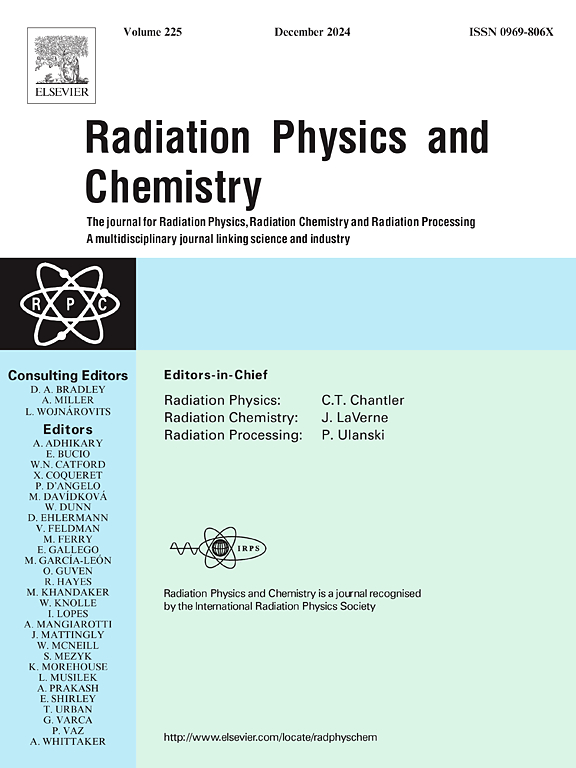Structural, morphological and electrochemical characteristics of gamma irradiated silver metaphosphate AgPO3 glasses
IF 2.8
3区 物理与天体物理
Q3 CHEMISTRY, PHYSICAL
引用次数: 0
Abstract
Silver metaphosphate AgPO3 glass samples were prepared using the melt quenching route. The prepared samples were exposed to a total gamma irradiation dose of 0–100kGy in steps of 20 kGy. The work aims to investigate the influence of gamma irradiation on the structure, morphology, and electric/dielectric properties of AgPO3 glass samples. X-ray diffraction (XRD) shows that the samples have some degree of crystallinity, and gamma irradiation has a small influence on the glass structure. Scanning electron microscope (SEM) shows that gamma irradiation has induced damage to the surface. Energy dispersive X-ray spectrometry (EDS) analyses demonstrate a nearly similar Ag and P atomic percentage in all samples, whereas the atomic percentage of oxygen is somewhat lower than its compositional percentage. Fourier-transform infrared spectroscopy (FTIR) and Raman spectroscopy were used to investigate any structural changes that may occur due to gamma irradiation. Impedance measurements reveal that the DC conductivity, activation energy, hopping energy, dielectric constant, and dielectric loss all decrease with increasing gamma dose, reaching a minimum in the dose range 40–60 kGy and then increase again when the dose is further increased. The AC conductivity of all samples follows Jonscher's power law, and analysis of the temperature dependence of the exponent reveals that the conduction mechanism can be well described by the correlated barrier hopping model. Exposing the samples to gamma rays did not change the conduction mechanism. The effect of gamma irradiation on electric properties is discussed in terms of the possible creation of traps and conductive pathways.
γ辐照偏磷酸银AgPO3玻璃的结构、形态和电化学特性
偏磷酸银 AgPO3 玻璃样品是用熔融淬火法制备的。制备好的样品被置于总剂量为 0-100kGy 的伽马辐照下,每 20 kGy 为一阶段。这项工作旨在研究伽马辐照对 AgPO3 玻璃样品的结构、形态和电/介电性能的影响。X 射线衍射(XRD)显示样品具有一定程度的结晶性,伽马辐照对玻璃结构的影响较小。扫描电子显微镜(SEM)显示,伽马辐照对玻璃表面造成了破坏。能量色散 X 射线光谱(EDS)分析表明,所有样品中的 Ag 和 P 原子百分比几乎相似,而氧原子百分比略低于其成分百分比。傅立叶变换红外光谱(FTIR)和拉曼光谱用于研究伽马射线辐照可能导致的任何结构变化。阻抗测量结果表明,直流电导、活化能、跳跃能、介电常数和介电损耗都随着伽马剂量的增加而降低,在剂量为 40-60 kGy 时达到最小值,然后随着剂量的增加而增加。所有样品的交流电导率都遵循约舍尔幂律,对指数的温度依赖性分析表明,传导机制可以用相关势垒跳变模型很好地描述。将样品暴露在伽马射线下不会改变传导机制。伽马射线辐照对电学特性的影响将从可能产生的陷阱和导电通路的角度进行讨论。
本文章由计算机程序翻译,如有差异,请以英文原文为准。
求助全文
约1分钟内获得全文
求助全文
来源期刊

Radiation Physics and Chemistry
化学-核科学技术
CiteScore
5.60
自引率
17.20%
发文量
574
审稿时长
12 weeks
期刊介绍:
Radiation Physics and Chemistry is a multidisciplinary journal that provides a medium for publication of substantial and original papers, reviews, and short communications which focus on research and developments involving ionizing radiation in radiation physics, radiation chemistry and radiation processing.
The journal aims to publish papers with significance to an international audience, containing substantial novelty and scientific impact. The Editors reserve the rights to reject, with or without external review, papers that do not meet these criteria. This could include papers that are very similar to previous publications, only with changed target substrates, employed materials, analyzed sites and experimental methods, report results without presenting new insights and/or hypothesis testing, or do not focus on the radiation effects.
 求助内容:
求助内容: 应助结果提醒方式:
应助结果提醒方式:


